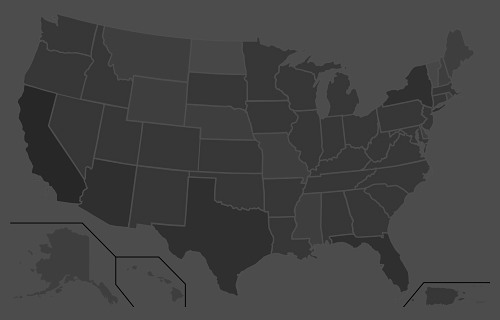“Our added winter moisture and active calling period led to a very long nesting and hatching season, starting in late April and extending into early summer, with chicks hatching as late as early July,” O’Dell said. “From a population standpoint, we are out of a deficit for the first time since 2001-2002. Quail are starting to pop up in places they haven’t been seen in a while.
“If you’ve never had the chance to experience what Arizona quail hunting built its name on, then this would be the year to get out and enjoy it.”
Meanwhile, hunters should note that the season for Mearns’ quail doesn’t begin until Dec. 4. It’s summer rainfall that plays a key role in nesting success and population numbers of this species. After a spotty and relatively weak monsoon across southern Arizona, these birds are likely to be abundant only in pockets that received sufficient precipitation this summer.
A valid Arizona hunting or combination hunt and fish license is required for all hunters 10 and older. Those hunters under 10 must either have a valid hunting or combination hunt and fish license, or be accompanied by an adult who possesses a valid hunting or combination hunt and fish license. Licenses can be purchased online or at license dealers statewide. A youth combination hunt and fish license (ages 10 to 17) is $5.
The general bag limit is 15 quail per day in the aggregate, of which no more than eight may be Mearns’ quail (when the Mearns’ season opens Dec. 4). The general possession limit is 45 quail in the aggregate after opening day, of which no more than 15 Gambel’s, scaled or California quail in the aggregate may be taken in any one day. After the opening of the Mearns’ season, the 45-quail possession limit may include 24 Mearns’ quail, of which no more than eight may be taken in any one day.
More quail-hunting information can be found on the department’s website at https://www.azgfd.com/Hunting/. Another resource for both new and experienced hunters alike is “An Introduction to Hunting Arizona’s Small Game.” Written by Randall D. Babb, the 196-page, full-color book covers where and how to hunt small game birds (like quail), squirrels, rabbits, ducks and geese. It also includes how to prepare and cook your harvest, with illustrations and recipes. The book can be ordered for $16.95 at www.azgfd.gov/publications.
Finally, hunters should check out O’Dell’s techniques for field-dressing quail at https://www.youtube.com/watch?v=3gRwZAcWzzk.
####
Publishers Notes: OUT OF STATE HUNTERS, FISHERMEN & OUTDOOR ENTHUSIASTS; Due to the Covid 19 pandemic, there could be limitations for OUT of STATE hunters, fishermen and other outdoor enthusiasts to include a 14-day quarantine requirement or negative COVID-19 testing alternative. Please check with the State's Department of Natural Resources BEFORE you travel or apply for the 2020 Fall Hunts.
Disclaimer: The views expressed on this site are that of the authors and not necessarily that of TBC Press
Minnesota 2020 Testing Showed Low Prevalence of CWD
Submitted by: TBC Press
Posted on: 02/03/21
The Backcountry Press
The country's premier daily HUNTING, FISHING & OUTDOOR news in the USA and around the globe. Read whats happening in your neck of the woods & beyond.
© 2020 TBC Press - All Rights Reserved Website Design by:
News # 14196
Some test results from the year’s management activities and any deer reported sick or dead are still pending; results will be updated on the DNR’s CWD webpage at https://www.dnr.state.mn.us/cwdcheck as they become available.
The DNR monitors CWD by testing wild deer. When the disease is detected in either captive or wild deer, the DNR establishes surveillance areas and tests wild deer for at least three years after the detection. This is because it can take 1 ½ to 3 years before a deer shows clinical symptoms. If three consecutive years of test results fail to confirm CWD, and an adequate number of deer are sampled, the DNR will end surveillance in an area. Details are in the DNR’s CWD response plan.
In fall 2020, the DNR shifted to voluntary self-service sampling to facilitate social-distancing measures at sampling stations during the COVID-19 pandemic. With the shift, the DNR set sampling goals based on the best available science that gives the agency confidence about disease prevalence in an area. While the majority of areas received enough samples to meet sampling goals and give confidence about disease detections, some surveillance areas did not.
The DNR will continue sampling for disease in these areas to enhance confidence about disease detection.
“We appreciate all those who participated in sampling this year. Each deer tested gives valuable information that contributes to our understanding of the disease’s prevalence and geographic distribution in our herd,” Hildebrand said.
Current management actions
Where CWD has been detected in wild deer, the DNR uses a three-pronged approach to limit the spread of the disease and keep Minnesota’s wild deer population healthy: reducing deer densities, restricting deer feeding and attractants, and limiting deer carcass movement.
This year, in areas where CWD-positive deer were detected, the DNR held two special hunts after the firearms hunting season and also provided landowners within a 3-mile radius of positive deer with shooting permits to further reduce deer densities.
From February through March, the DNR will work with the U.S. Department of Agriculture-Wildlife Services to complete targeted culling in focused areas where CWD has been detected in wild deer. Venison from these deer that do not test positive for CWD will be donated through the Share the Harvest program. More information about the program is available on the DNR website at https://www.dnr.state.mn.us/cwd/share-harvest.html.
Final CWD test results will influence how the DNR manages the disease going forward and determines the 2021 hunting regulations, which will be released in August.
Additional CWD information
Keeping Minnesota’s wild deer population healthy remains the goal of the DNR’s response to chronic wasting disease. Since CWD was first detected in Minnesota in 2002, the DNR has tested more than 90,000 wild deer in the state. To date, 110 wild deer have tested positive for CWD in Minnesota. CWD test results, including locations of confirmed positive test results and statistics, are available on the DNR website at mndnr.gov/cwdcheck.
As part of its CWD response plan, the DNR monitors and manages for CWD in disease management zones around areas where the disease has been detected in wild deer. The CWD management zones are located in the southeast, north-central and south metro areas of Minnesota. The DNR monitors for the disease in surveillance areas where CWD has been found in captive deer farms or which are adjacent to other areas of known risk located in the east-central, west-central and south metro areas of Minnesota.
For more information on chronic wasting disease, including maps of CWD surveillance areas, frequently asked questions and hunter information, visit mndnr.gov/cwd.
####
Publishers Notes: Our country is still battling COVID-19. To avoid the spread of this virus and continue to enjoy outdoor activities, ALL outdoor enthusiasts (man, woman, child) should follow the guidelines set by nps.gov. These guidelines include; social distancing, the Leave No Trace principles, including pack-in and pack-out, to keep outdoor spaces safe and healthy.
Testing results from Minnesota’s 2020 hunting season and early 2021 special hunts confirmed chronic wasting disease in 22 wild deer, all within current disease management zones, according to the Minnesota Department of Natural Resources.
In total, 7,682 samples were tested from hunter-harvested deer or opportunistic samples (deer killed by vehicles, reported sick or found dead). Nineteen of the positives were from deer in the southeast management zone and three were from the south metro management zone.
CWD was not detected in the north-central disease management zone, the southeast control zone, or the surveillance areas put in place for the 2020 hunting season. The surveillance areas added in 2020 were in east-central and west-central Minnesota, as well as a south metro surveillance area that surrounds the south metro management zone.
“Though CWD is detected in Minnesota’s wild deer, our recent test results show that the disease prevalence remains relatively low,” said Erik Hildebrand, DNR wildlife health specialist.












